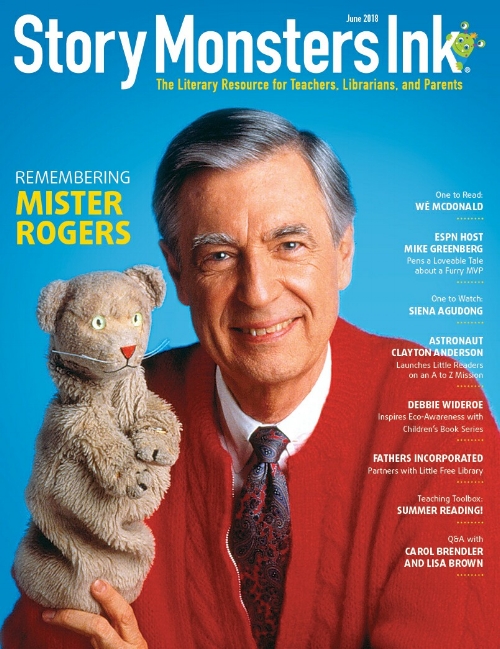Remembering Mister Rogers
/by Melissa Fales
photos courtesy of The Fred Rogers Company
Fifty years ago, children scattered in living rooms across America were first invited to visit Mister Rogers’ Neighborhood. Beginning in 1968, Fred Rogers became an on-screen friend to countless young people who were drawn in and put at ease by his calm demeanor, melodious voice, and his assertion that he liked them, just the way they were.
Ironically, as Rogers often shared, it was his dislike for the medium of TV that led him to create the beloved show. He once told CNN’s Jeff Greenfield, “I went into television because I hated it so, and I thought there’s some way of using this fabulous instrument to nurture those who would watch and listen.”
Born in 1928 in Latrobe, Pennsylvania, Rogers grew up singing and playing the piano at the knee of his maternal grandfather, Fred McFeely. He attended Rollins College, earning a Bachelor’s Degree in Music Composition in 1951 and meeting the woman who would later become his wife, concert pianist Joanne Byrd.
Rogers got his start in television working for NBC right out of college, parlaying his significant musical ability into jobs on shows such as The Voice of Firestone, The Lucky Strike Hit Parade, and The Kate Smith Hour. He also dabbled in work for several children’s shows, but his aversion to the merchandising so closely tied into children’s programming led him elsewhere.
In 1954, Rogers began working as a puppeteer on The Children’s Corner, a Pittsburgh Public Television show, where he found relief from the consumerism of commercial TV. During the several years he spent with the show, he introduced some of his most beloved puppet characters: King Friday XII, Henrietta Pussycat, Lady Elaine Fairchilde, and Daniel Striped Tiger.
Rogers also spent time in Canada, working on a short-lived children’s program called Misterogers where some of his most recognizable backdrops and props originated, including the trolley, the huge tree, and the majestic castle belonging to his highness, King Friday XII. Rogers later acquired the rights to that show and returned to Pittsburgh where he created Mister Rogers’ Neighborhood. It first aired nationwide in 1968 through National Educational Television, a precursor to Public Broadcasting Service (PBS).
In 1969, the impactful testimony Rogers gave in front of the United States Senate Subcommittee on Communications in support of funding for PBS and the Corporation for Public Broadcasting was hailed as a game-changer. In his soft-spoken manner, Rogers deftly made the case that children’s programming on public television addressed a need in society and served as an antithesis to the troubling messages that so commonly infiltrated television programming. He also sang one of his songs from Mister Rogers’ Neighborhood. Instead of the cuts that were planned, Congress went on to appropriate $22 million, more than double the previous years’ funding for public broadcasting, and Committee Chairman Senator John Pastore famously told Rogers that he’d earned those millions.
Those funds also helped the PBS hit show Sesame Street become the blockbuster it was. Sonia Manzano, who portrayed Maria on Sesame Street for 44 years, appreciated how Rogers’ show complemented hers. “Sesame Street and Mister Rogers’ Neighborhood were the perfect combination of children’s programming in the early 1970s, with Sesame Street’s emphasis on cognitive skills and Mister Rogers’ emphasis on social, emotional interaction,” she says.
Each episode of Mister Rogers’ Neighborhood opens the same way, with Rogers returning home singing, “Won’t You Be My Neighbor?” before changing into his trademark sneakers and cardigan sweater. Episodes typically feature interactions with various “neighbors” and make-believe adventures with puppets, interspersed with Rogers’ musical compositions. The concept behind the show relies largely on his soothing presence, unhurried pace, and ability to connect with children.
During most episodes, Rogers takes his viewers on a field trip, introducing children to the types of places one might find in a neighborhood. One such field trip was to author/illustrator Eric Carle’s studio. “It was an honor to work with him and appear on his TV show,” says Carle. “We read my book From Head to Toe together and painted tissue papers. It was an absolute pleasure to visit and paint papers together, both of us in our white smock jackets. The way he spoke to children was so calm and kind and respectful. I will always remember Fred with great fondness and admiration. We are so fortunate for all that he gave to the world.”
The best part about Mister Rogers’ Neighborhood is that Rogers was simply being himself on screen. “One of the greatest gifts you can give anybody is the gift of your honest self,” Rogers once said. “I also believe that kids can spot a phony a mile away.” That’s how he lived his life and how he filmed his television program. “Fred Rogers was authentic,” says Manzano. “That’s why all the satirized versions of Mister Rogers’ Neighborhood that we all enjoyed, couldn’t touch or diminish him.”
Many children, like author Kate DiCamillo, found refuge in Rogers’ placidity. DiCamillo, who was often ill as a child, still remembers how he made her feel every time she watched an episode. “I spent a lot of time in the hospital when I was really young, and I remember the nurses letting me sit on a green, vinyl-covered couch in the hospital lounge (this was before hospital rooms had TVs) so that I could watch Mister Rogers,” she says. “I remember feeling lousy. I remember that the vinyl of the couch was cold against my legs. And I remember being worried that I would do something wrong and get sent back to my room and miss the show. And then Mister Rogers came on, and nothing mattered. I didn’t feel sick. I didn’t feel cold. I wasn’t worried. Mr. Rogers made me feel safe.”
Over the course of its three decades on air, Mister Rogers’ Neighborhood won four Emmy awards. Rogers earned a Lifetime Achievement Award, 40 honorary degrees, and induction into the Television Hall of Fame. Less than a year before Rogers passed away in 2003, President George W. Bush presented him with the Presidential Medal of Freedom, the nation’s highest civilian honor.
When it comes to Mister Rogers’ Neighborhood, however, it’s not about awards or accolades. Rogers never sought those out. Instead, it’s about how he made people feel and continues to make people feel today. And one thing everyone in the neighborhood can agree on is that “It’s such a good feeling, a very good feeling.” •
For more information about Fred Rogers and his legacy, visit fredrogers.org.
Find more stories like this in the June issue of Story Monsters Ink! The literary resource for teachers, librarians, and parents!






